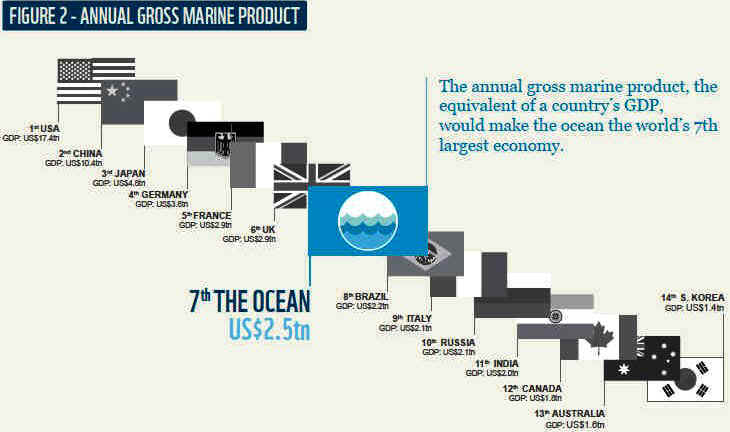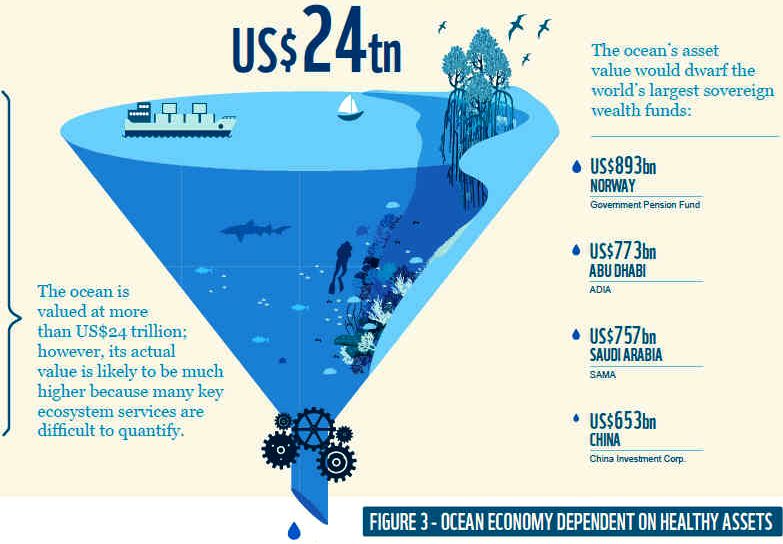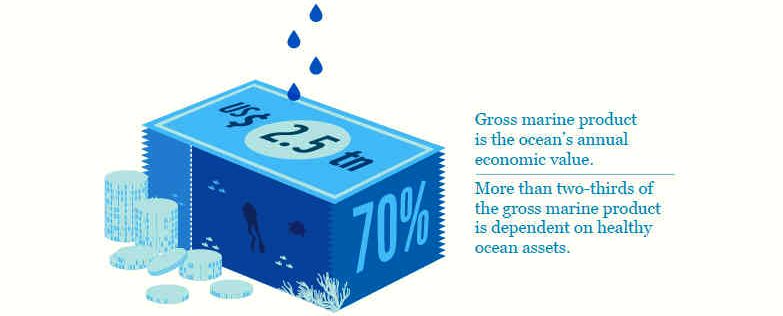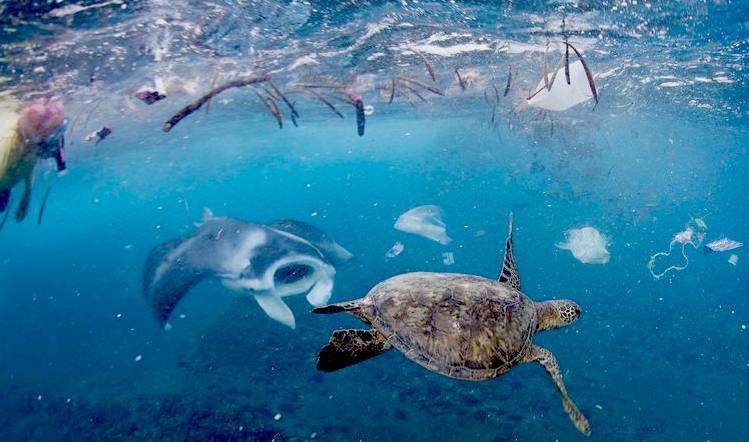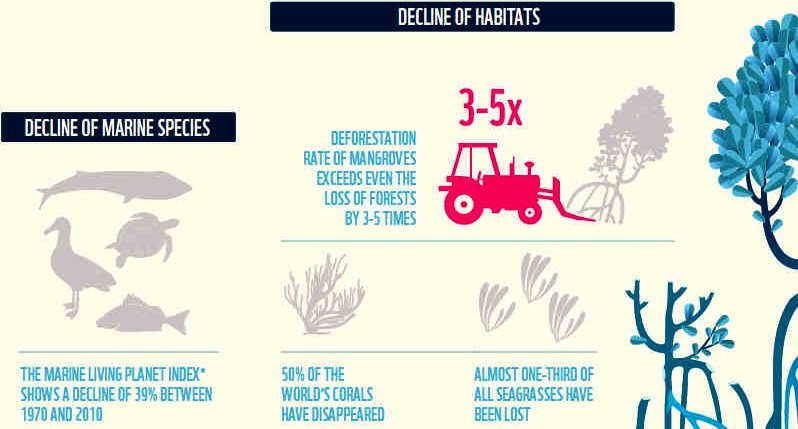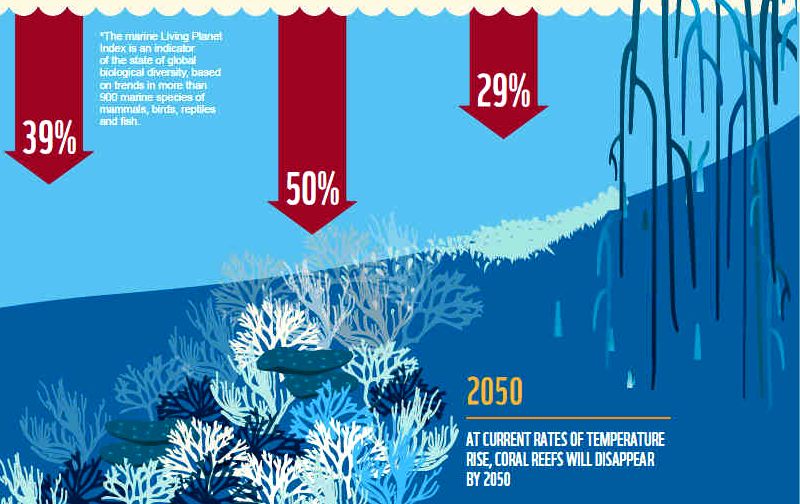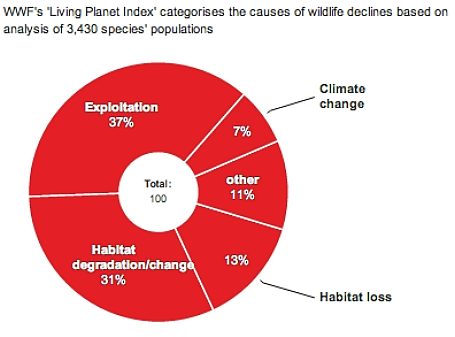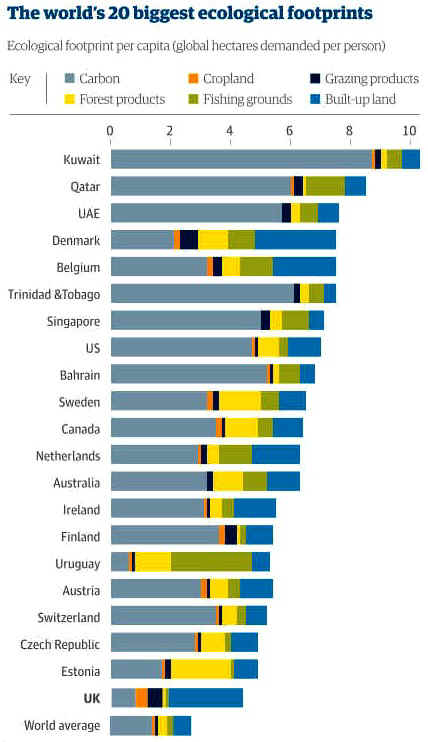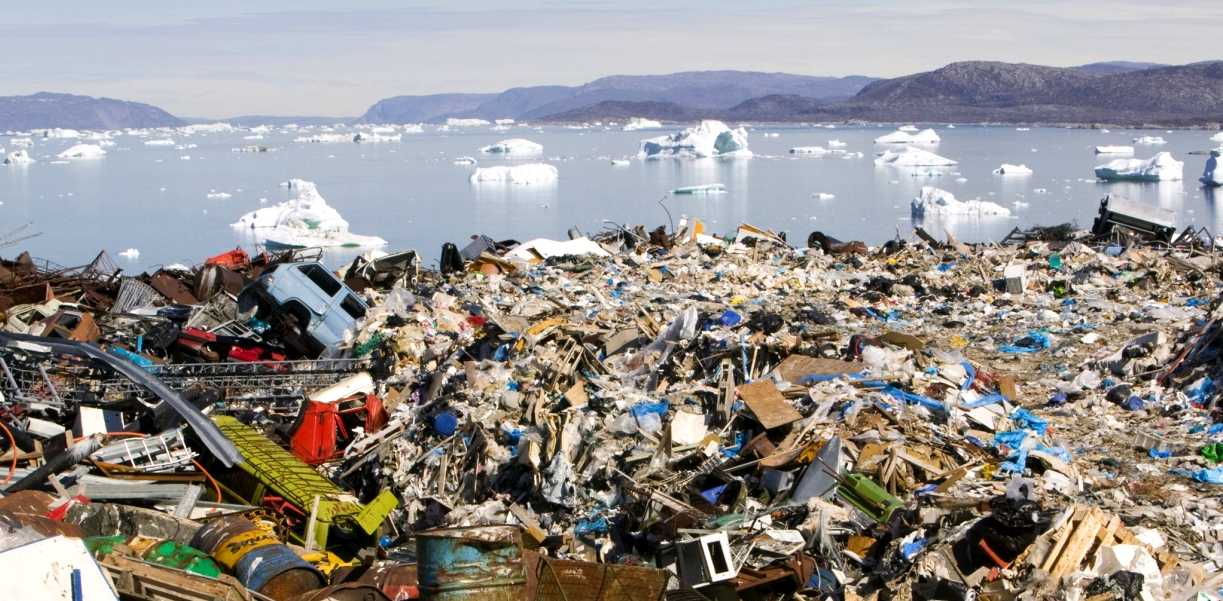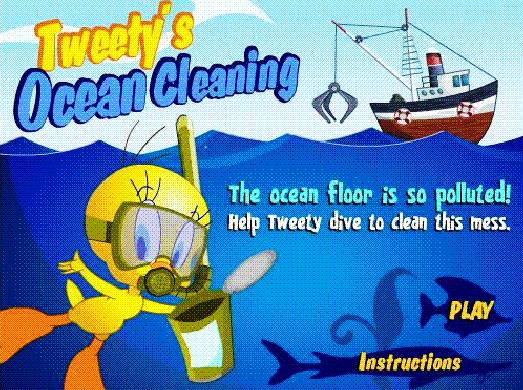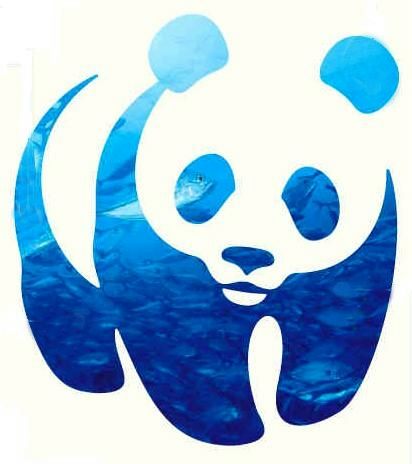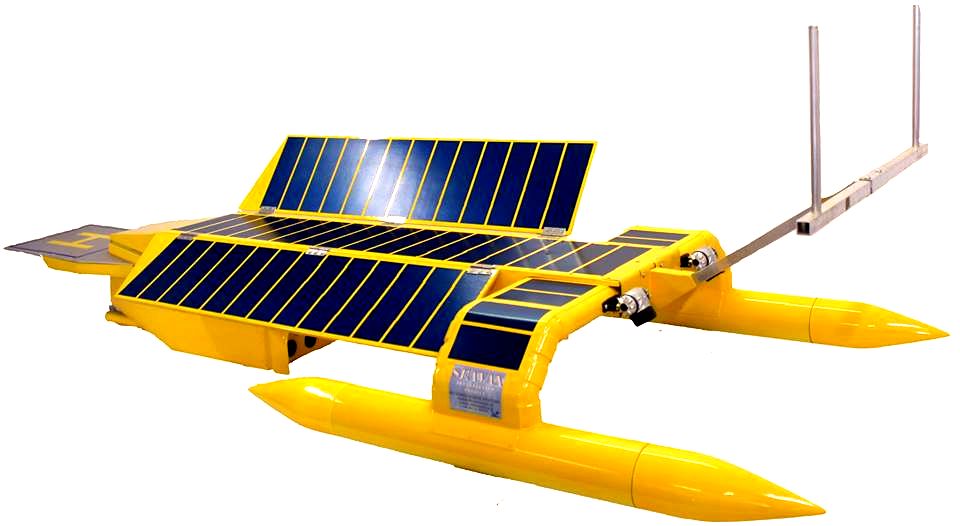|
WORLD WILDLIFE FUND - OCEAN ECONOMY REPORT 2015
|
||
|
FIGURE 1 - The global asset value of our oceans is shown in the WWF diagram above. It's not just food and transport, the value includes carbon absorption, tourism and much more.
FUNDAMENTAL SYSTEM TO SUPPORT HUMANS
The ocean produces half the oxygen we breathe, and absorbs 30 per cent of the anthropogenic emissions of carbon dioxide (CO2) and around 93 per cent of the added heat arising from human-driven changes to the atmosphere.
The ocean is home to a largely uncatalogued diversity of life, from single-celled organisms to our planet’s largest creature, the blue whale. These species are intertwined in a complex food web within which humans play an increasing role.
The ocean’s services to humanity are very significant. Around 3 billion people obtain almost 20 per cent of their animal protein from fish, and the majority of the planet’s fish comes from the ocean. In some countries, as much as half of the animal protein consumed is fish. Fishing activities span the small-scale and daily gathering of marine life through to industrial-scale fishing where vessels can capture and process thousands of tonnes of seafood on a single voyage. The demand for protein from the sea has increased dramatically as human populations have grown. At the same time, agricultural systems are failing to keep up with the expanding demand for food.
FIGURE 2 - The annual gross marine product is compared to the GDP of the top 12 performing countries. Click on the picture above to see our suggested rate of contributions (SeaNet) to kickstart the recovery process.
FIGURE 3 - The annual gross marine product is compared to the GDP of the top 12 performing countries.
WWF EIGHT STEPS TO RESTORE THE “SHARED WEALTH FUND” OF THE OCEAN
If we consider the analogy of the ocean as a “shared wealth fund”, our principal capital is being eroded at a rate that undermines the ocean’s value for future generations. It is time to push the reset button before we drive our shared wealth fund to collapse.
The good news is that rapid action on a number of key issues will deliver real change and benefits for ocean systems and the people who depend on them. Some of the benefits could be reinstated in a relatively short period of time. Central to this is conserving habitat that is critical to the restoration of healthy and productive natural systems: the core assets of the ocean.
The opportunity is to galvanize an international movement that will take on this challenge. Leaders must prioritize the ocean and take the eight decisive actions that are outlined here for a better future for communities, ecosystems and businesses.
The eight actions proposed are achievable and logical, and many are mutually reinforcing. They are best taken at the same time; however we recommend that the first three actions be prioritized for 2015.
ACTION 1 Governments must embrace the Sustainable Development Goals, with their strong targets and indicators for the ocean, and commit to coherent policy, financing, trade and technology frameworks to restore and protect ocean ecosystems as part of the UN Post-2015 Agenda process.
ACTION 2 Leaders must address the serious problems of ocean warming and
acidification. We must listen to science and make the deep cuts in emissions
that will prevent further increases in dangerous climate change. It is vital
that the world signs on to an ambitious international agreement in Paris in December 2015 (COP21) that will allow the rapid decarbonization of our
ACTION 3 Coastal countries must deliver against the agreed target for at least 10 per
cent of coastal and marine areas to be conserved and effectively managed by 2020, with an increase to 30 per cent by 2030. This is not just about
the extent of area protected; it is about establishing ecologically coherent,
representative networks of marine protected areas that help ensure the
ACTION 4 Habitat protection and fisheries management must go hand in hand. Institutional arrangements for managing the ocean should reflect the fact that an integrated approach for ecologically managed fisheries must focus on ecosystem resilience and function, as well as economic and social well-being.
ACTION 5 Global crises require global solutions. Given the transboundary nature of
the ocean, we need appropriate international mechanisms for negotiation and collaboration to ensure its sustainable management. Formation of a
“Blue Alliance” of concerned maritime states will provide leadership and
build the case for a rapid and comprehensive set of actions on behalf of the ocean. Such a coalition could cultivate international will and foster the
shared global responsibility and informed decision-making that are crucial
when it comes to ocean resources. It will also be important to establish a
global fund to support countries that have fewer resources and are more
ACTION 6 Appropriately structured public-private partnerships that take into account the well-being of communities, ecosystems and business have the potential to revolutionize how sectors work together sustainably. Enabling a network of such cross-sectoral partnerships (public, private and community) to share ideas, solutions and blueprints for sustainable practices will ensure that even the least developed countries will have access to the necessary resources.
ACTION 7 Communities and countries must develop complete, transparent and public accounting of the benefits, goods and services that the ocean provides. Valuing the ocean’s assets is vitally important to helping inform effective decision-making.
ACTION 8 There is a need for an international platform to support and share ocean knowledge through which problems can be understood, and solutions and methodologies evaluated and applied. Such a platform must be interdisciplinary and informed by biological, social and economic data. This platform will build capacity and improve access to critical information and expertise.
These eight actions offer a clear plan for reviving the ocean economy. This year, 2015, is particularly important and opportune to forge global leadership and investment for the ocean. In 2015, two historic international agreements could be struck with provisions that have the potential to arrest the decline in ocean health, and shift toward a trajectory of ocean restoration. The year also marks an important opportunity for countries to harness the growing momentum on ocean conservation and sustainable use, and collectively make clear commitments on habitat conservation.
The WWF report acknowledged and builds on the work of other institutions engaged in ocean conservation including the Global Partnership for Oceans convened by the World Bank, the Global Ocean Commission and others.
A Manta Ray and Sea Turtle swim in a toxic plastic soup that is polluting our oceans and retarding healthy growth. The challenge to clean this mess up is huge. Plastic garbage is spread over millions of square miles. It is made up mostly of degraded plastic, broken down by sunlight and waves into tiny bits the size of grains of rice. Roughly 2.5 percent of the world's plastic ends up in the sea.
CNN NEWS - APRIL 23 2015
The world’s seventh-largest economy is heading toward collapse. An economic powerhouse conservatively valued at $24 trillion, one that annually churns out the equivalent of $2.5 trillion, is under assault. However, I am not referring to one of the G8 economies, but to the “super economy” of the ocean. It’s one that for far too long has been ignored and taken for granted — and it is going downhill fast.
The health and wealth of the ocean are assessed in a WWF report released Thursday, Reviving the Ocean Economy. The report is the result of a hard economic analysis performed by The Boston Consulting Group built on a foundation of the latest ocean science provided by the Global Change Institute of the University of Queensland.
True, the enormity of the ocean can complicate any single appraisal. But it is still important to try to understand its value if global leaders are ever going to sustain it for future generations.
The fact is that the ocean feeds us, employs us, offers protection and plays a direct role in the lives and livelihoods of people throughout the world. The ocean also provides intangible but essential services to humanity, such as climate regulation and oxygen production, that are difficult to put in monetary terms. And while we all may look at the ocean from different perspectives, no one can escape the fact that it is a shared resource that provides for each and every one of us.
A figure that may get lost in the headlines generated by our report is perhaps most telling: Seventy percent of the ocean's overall economic value relies on its continued health. Ocean assets like fisheries, coral reefs, mangroves and seagrasses that produce goods and services rivaling the world's top 10 economies will lose their value if we continue to over-exploit and outright destroy them.
The WWF claims to be taking action for the ocean. See how by clicking on the picture above.
23
APRIL 2015 - INTERNATIONAL BUSINESS TIMES
WWF REPORT 2015 - Echoes the findings in a Guardian newspaper article in 2014, where much of their reference material was from the WWF.
WWF-UK CEO David Nussbaum said: "Our oceans are a climate regulator and carbon sink, supporting future global economic growth, as well as providing critical goods and services that underpin the well-being of billions of people. But rising temperatures and increased
acidification put all this at risk.
Each year, oil companies remove approximately 3.7 trillion gallons of oil from the earth. This oil is transported by barges, ocean going tankers, and pipelines to refineries and storage facilities. It is inevitable that accidental leaks and spills will take place on a regular basis, where oil is mostly transported across vast oceans. That is the first stage of oil pollution. The second stage is oil byproduct pollution from plastic. Our use of oil and plastic causes ocean habitat degradation. Burning oil causes global warming and climate change causes acid oceans.
THE GUARDIAN 2014 - EARTH HAS LOST 50% OF WILDLIFE IN LAST 40 YEARS
The number of wild animals on Earth has halved in the past 40 years, according to a new analysis. Creatures across land, rivers and the seas are being decimated as humans kill them for food in unsustainable numbers, while polluting or destroying their habitats, the research by scientists at WWF and the
Zoological Society of London found.
CAUSES
OF WILDLIFE DECLINE GLOBALLY
The report concludes that today’s average global rate of consumption would need 1.5 planet Earths to sustain it. But four planets would be required to sustain US levels of consumption, or 2.5 Earths to match UK consumption levels.
The fastest decline among the animal populations were found in freshwater ecosystems, where numbers have plummeted by 75% since 1970. “Rivers are the bottom of the system,” said Dave Tickner, WWF’s chief freshwater adviser. “Whatever happens on the land, it all ends up in the rivers.” For example, he said, tens of billions of tonnes of effluent are dumped in the Ganges in India every year.
As well as pollution, dams and the increasing abstraction of water damage freshwater systems. There are more than 45,000 major dams – 15m or higher – around the world. “These slice rivers up into a thousand pieces,” Tickner said, preventing the healthy flow of water. While population has risen fourfold in the last century, water use has gone up sevenfold. “We are living thirstier and thirstier lives,” he said.
But while freshwater species such as the European eel and the hellbender salamander in the US have crashed, recoveries have also been seen. Otters were near extinct in England but thanks to conservation efforts now live in every county.
The number of animals living on the land has fallen by 40% since 1970. From forest elephants in central Africa, where poaching rates now exceed birth rates, to the Hoolock gibbon in Bangladesh and European snakes like the meadow and asp vipers, destruction of habitat has seen populations tumble. But again intensive conservation effort can turn declines around, as has happened with tigers in Nepal.
Marine animal populations have also fallen by 40% overall, with turtles suffering in particular. Hunting, the destruction of nesting grounds and getting drowned in fishing nets have seen turtle numbers fall by 80%. Some birds have been heavily affected too. The number of grey partridges in the UK sank by 50% since 1970 due to the intensification of farming, while curlew sandpipers in Australia lost 80% of their number in the 20 years to 2005.
The biggest declines in animal numbers have been seen in low-income, developing nations, while conservation efforts in rich nations have seen small improvements overall. But the big declines in wildlife in rich nations had already occurred long before the new report’s baseline year of 1970 – the last wolf in the UK was shot in 1680.
Also, by importing food and other goods produced via habitat destruction in developing nations, rich nations are “outsourcing” wildlife decline to those countries, said Norris. For example, a third of all the products of deforestation such as timber, beef and soya were exported to the EU between 1990 and 2008.
David Nussbaum, chief executive of WWF-UK said: “The scale of the destruction highlighted in this report should be a wake-up call for us all. But 2015 – when the countries of the world are due to come together to agree on a new global climate agreement, as well as a set of sustainable development goals – presents us with a unique opportunity to reverse the trends. “We all – politicians, businesses and people – have an interest, and a responsibility, to act to ensure we protect what we all value: a healthy future for both people and nature.”
Al Jazeera's Nick Clark reports on endangered oceans from Doha, Qatar
LINKS
CNN news 2015 April 23 opinions lambertini ocean economy World Wildlife Fund reviving the oceans economy the case for action 2015 The Guardian environment 2014 September earth has lost-50 percent of wildlife in 40 years wwf Al Jazeera news 2015 April wwf report warns danger oceans http://www.zsl.org/ http://www.theguardian.com/environment/2014/sep/29/earth-lost-50-wildlife-in-40-years-wwf http://www.aljazeera.com/news/2015/04/wwf-report-warns-danger-oceans-150423142317932.html http://www.ibtimes.co.uk/wwf-ocean-important-business-asset-24tn-economic-value-quickly-deteriorating-1497832 http://theterramarproject.org/thedailycatch/worlds-seventh-largest-economy-headed-toward-collapse-the-ocean/ http://edition.cnn.com/2015/04/23/opinions/lambertini-ocean-economy/ https://www.worldwildlife.org/publications/reviving-the-oceans-economy-the-case-for-action-2015
A SEAVAX DRONE - This is a raw proposal for a robot ship that is designed to vacuum up plastic waste from the ocean based on the Bluefish ZCC concept. The vessel is solar and wind powered - and shares component with other ZCC variants. The front end (left) is modified so that there is a wide scoop area, into which plastic waste is funneled as the ship moves forward. The waste is pumped into a large holding bay after treatment, then stored until it can be off-loaded. The rear of the ship (right) carries two large wind turbines that generate electricity in combination with deck mounted solar panels to power the onboard processing machinery. The system can be semi-autonomous, such that in robot mode the vessel alerts and operational HQ to any potential problems and shares information as to progress for stake holders. The entire cleanup mission can be controlled from land, with visuals and data streams. A SeaVax ship would operate using a search program called SeaNet.
ACIDIFICATION - ADRIATIC - ARCTIC - ATLANTIC - BALTIC - BAY BENGAL - BERING - CARIBBEAN - CORAL - CORAL SEA - EAST CHINA ENGLISH CH - GOC - GUANABARA - GULF GUINEA - GULF MEXICO - INDIAN - IRC - MEDITERRANEAN - NORTH SEA - PACIFIC - PERSIAN GULF - SEA JAPAN
AMAZON - BURIGANGA - CITARUM - CONGO - CUYAHOGA - GANGES - IRTYSH - JORDAN - LENA - MANTANZA-RIACHUELO MARILAO - MEKONG - MISSISSIPPI - NIGER - NILE - PARANA - PASIG - SARNO - THAMES - YANGTZE - YAMUNA - YELLOW
|
||
|
This website is Copyright © 2017 Bluebird Marine Systems Ltd. The names Bluebird™, Bluefish™, SeaVax™, SeaNet™ and the blue bird and fish in flight logos are trademarks. CONTACTS The color blue is a protected feature of the trademarks.
|

